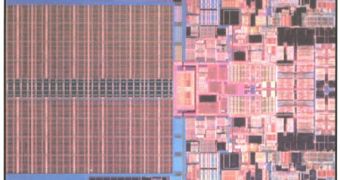Intel's next generation of processor, the Penryns, are intended for both desktop and mobile computing systems and on the mobile segment they will replace gradually the Morom core architecture that is now used by the Core 2 Duo family. Core 2 Duo processors based on the Merom core are produced with the 65 nanometer technology, but the Penryn class will benefit from the newer 45nm fabrication process and this should give them a number of advantages.
Intel's mobile computing platform, named Santa Rosa, will receive the Penryn processors sometime during the first quarter of 2008 and the manufacturer planned four Penryn class CPUs for release. While the exact model names are not known yet, Intel provided a number of details about the coming mobile Penryns, like clock speed, frontside bus frequency and level 2 cache memory. Just like the older, second generation Meroms that are widely used today, the mobile Penryns will feature a frontside bus with a standard frequency of 800MHz, that is somewhat lower than the standard 1066 or 1333MHz FSB (the shorthand for frontside bus) of the desktop processors.
Mobile processors from the Penryn class will arrive with pretty high standard running clock speeds of 2.1, 2.4, 2.5, 2.6 and 2.8GHz, while their level two of cache memory will stay in the 3 to 6MB range. From existing Meroms, Intel claims that the Penryns received core improvements for both performance and energy efficiency, like a better Wide Dynamic Execution, Advanced Smart Cache, Advanced Digital Media Boost and Intelligent Power Capability. Apart from these improvements, Intel focused on the multimedia extended instruction set, now at its fourth iteration under the name SSE. The SSE4 will introduce 47 new instructions to the Penryn processors, both mobile and desktop intended, that are targeted for increased video acceleration, graphics processing and streaming load.
According to Intel and cited by the news site PC210, those SSE4 instruction should enable Penryns to double their performance in video related tasks. Because the power conserving features are very important in mobile computing, as they are directly linked with the battery life and processor dissipated heat, Intel introduces new power saving policies and enhanced already existing ones. The deep power down state is one of the new energy saving features of the Penryns, that enables the processor to lower its core voltage and shutdown both its cache memories. The first Penryn processors are expected to hit the market in the first months of 2008 as a part of the upgraded Santa Rosa platform, while the new mobile platform Montevina platform will be launched later.

 14 DAY TRIAL //
14 DAY TRIAL //